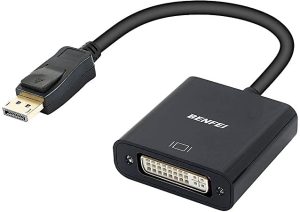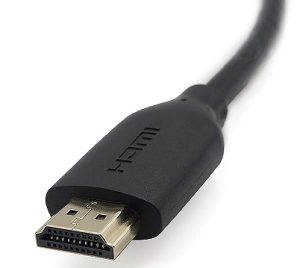DVI and HDMI are two cables that are used to connect your pc to a monitor or a TV. DVI is slightly old technology and it is not as capable or popular as HDMI. However, it is still a viable choice for 1080p resolution and one that is slightly cheaper than an HDMI cable.
In this article, we will be looking at the differences between HDMI and DVI cable and their technical aspects. Read on to find out more.
Outline
ToggleDVI
DVI (Digital Visual Interface) is a video-only connection. It is still available on most Graphics cards but it does not have the ability to transmit audio signals. This is the biggest difference between an HDMI and DVI cable. It supports 144Hz refresh rates and therefore is a good choice for 1080p gaming. Single-link DVI cables can handle 1080p resolution but dual-link cables can handle a resolution of 2560*1600 resolution as well. However, 4K resolution is not possible and for that, you would need a DisplayPort or an HDMI cable. Also, you can adapt DVI to VGA with the help of a passive adapter.
HDMI
HDMI(High Definition Media Interface) is the standard currently. It can transmit audio signals as well. It is capable of handling most resolutions. HDMI is the choice to connect your pc into the tv. HDMI 1.4 can display 4K at 30Hz while HDMI 2.0 and above can display 4K at 60Hz. Also, it is backward compatible with DVI. There are also HDMI cables with ethernet support as well.
Comparison Chart
| Features | DVI | HDMI |
| Audio | No | Yes |
| Maximum Channels | 6 for dual link | 8 |
| Data Speed | 9.9 Gbps | 18 Gbps |
| Max Resolution | 2560*1600 for dual link | 4K/60Hz |
| Analog/Digital combination | Yes | No |
Major Differences between DVI and HDMI Cables
1. Usage
DVI is widely used in Desktop computers and older LCD displays. HDMI is seen in all the latest HDTVs, Apple TV, Gaming Consoles, and much more. It is more prevalent than DVI nowadays.
2. Capabilities
DVI can handle 1080p resolution and even 2560*1600 on dual-link connectors. However, it cannot support HDCP encryption and therefore will be unable to handle Blue Ray content.
HDMI is able to stream audio and video together and supports 4K resolution at 60Hz. Additionally, it offers support for 8 channel audio and HDCP encryption and therefore is a much better choice than DVI for gaming and entertainment purposes.
3. Compatibility
DVI can be attached to an HDMI port with the help of a digital converter. Since it does not support audio, a separate cable is necessary. It can also work with monitors that only have a VGA port.
4. Quality & refresh rates
HDMI 1.4 supported 4K at 24Hz which in itself was quite impressive. However, HDMI 4.0 supports 4K at 60Hz which is immense. Moreover, HDMI also has HDR technology which allows for increased levels of detail in bright and dark areas. Also, it supports HDCP copy encryption which stops HD content from being played on devices that are unauthorized to do so. This feature is absent in DVI.
Both HDMI and DVI can output 144 Hz at 1080p. The higher refresh rates offer a much smoother experience and reduce eye strain and headaches.
5. Types
Types of HDMI connectors
There are 5 different types of HDMI connectors-A,B,C,D, and E. Both type A and type B use HDMI 1.0 but type B is dual-link compatible while type A supports a single link. Also, type A uses 19 pins while type B uses 29 pins. Type C has HDMI 1.3 and is used by portable devices. Type D has HDMI 1.4 and has 19 pins just like type C. Type E also uses HDMI 1.4 but is much tougher and is designed to withstand vibrations, and dust.
Types of DVI connectors
There are 3 main types of DVI connectors-DVI-D, DVI-A, and DVI-I. DVI-D makes use of digital format and is commonly used to connect computers to LCD screens. DVI-A uses analog and can be used to connect computers with older analog displays. DVI-I supports both Analog as well as digital connections and is the best choice in our opinion.
6. Layout
There are some considerable differences between HDMI and DVI in appearance. HDMI appears quite simple in design and is much smaller. DVI on the other hand appears quite complex and is larger. The most common version of DVI is one with a 24 pin.
7. Price
HDMI cables are generally more expensive when compared to DVI cables. However, there are different brands making different variants and you are bound to get some models which are relatively cheaper.
Final Words
We hope this guide would have helped you to understand the differences between DVI and HDMI. DVI was the past and HDMI is the future. HDMI improves on DVI in almost every way. For any queries regarding the content, do write to us.



